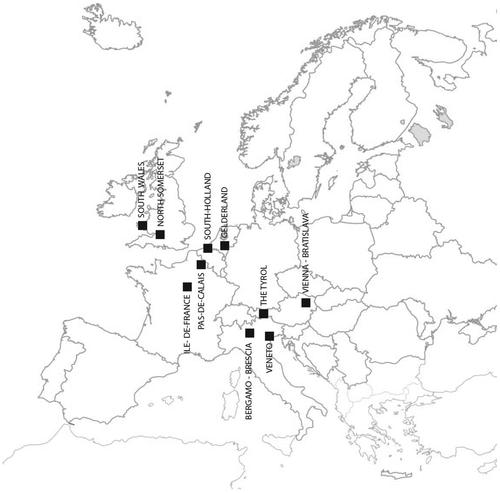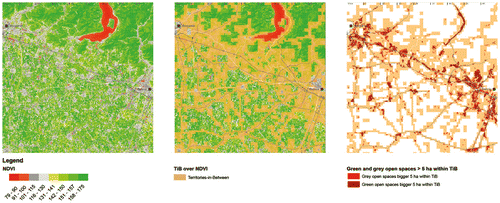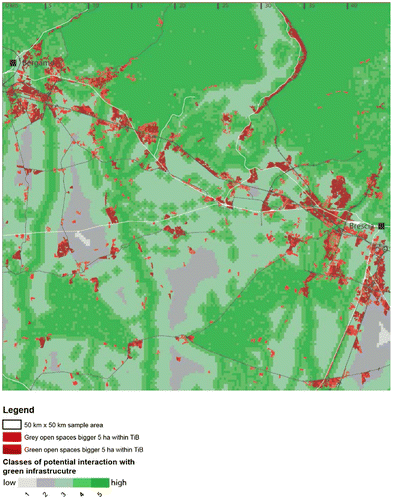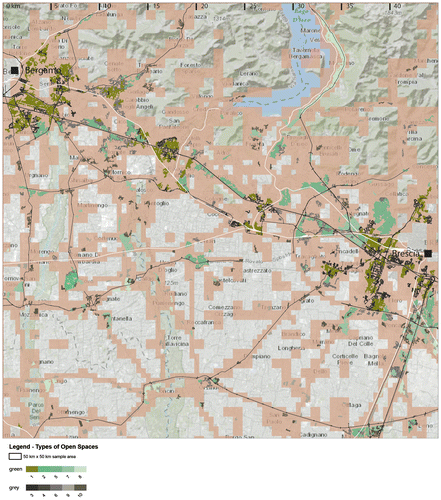Abstract
To improve the ecosystem service provided by open spaces in dispersed urban areas is a key challenge for sustainable spatial development in Europe. The typology presented in this article illustrates the different potentials that open spaces in territories-in-between have across 10 cases in Europe. Unlike other typologies, neither function nor form is used for the classification, but the potential interaction of open spaces with social, technical and ecological networks. Therefore, the typology informs regional spatial planning and design about the potential ecosystem services in networked urban regions. Thereby the importance of territories-in-between, which are often neglected by mainstream spatial planning and design, for sustainable development is highlighted.
1. Introduction
Much of the territory of Europe is neither distinctly urban nor rural but something ‘in-between’ (Ulied et al., Citation2010) The latest EUROSTAT (Regional Statistics Team, Citation2013) urban–rural typology update shows that most Nomenclature des Units Territoriales Statistiques (NUTS 3) regions fall in this ‘in-between’ category, which covers 38.7% of Europe’s land surface, whereas urbanized areas cover 9.9%. 35.3% of the EU population live in these intermediate areas in relation to 42.4% in predominantly urban areas. Big parts of the areas classified as predominantly urban are actually low-rise dispersed urban development, like the metropolitan areas of the Randstad in the Netherlands, Flanders in Belgium, the Ruhrgebiet in Germany, as well as the suburban and peri-urban areas of larger European cities, like Milan, Paris, Prague, Vienna, Lisbon and Oporto, to name just a few examples. Hence, we can assume that the majority of Europeans are actually living in some sort of territory-in-between (TiB), which cannot be understood simply as an intensification of urban functions in the rural environment or places of interaction of urban and rural territories.
TiB play a crucial role for sustainable development, because of their extended geography and the large share of population living in them. The challenges to achieve a more sustainable urban development are related with their specific spatial, programmatic and cultural features (Garreau, Citation1992; Viganò, Citation2001; Sieverts & Bölling, Citation2004). Recent and multidisciplinary research questioned the linear relationship between urban dispersion and unsustainable development, and focuses on the missing policies for a sustainable dispersed urban development. Couch et al. (Citation2007, p. 264), for example, conclude from a comparison of sprawling areas across Europe:
Maybe sprawl is not anything sustainable, but again, it is no more unsustainable than other types of urban development. environmental policy for sustainability in sprawling areas of our city case studies was weak or non-existent, except perhaps in some instances in the North.
| • | social aspects of sustainability, like human health, well-being and the possibility to interact, socialize and recreate (Maas et al., Citation2006; Volker et al., Citation2006; Harnik, Citation2012); | ||||
| • | environmental aspects of sustainability, like protecting biodiversity by improving ecological functions, as well as providing and developing ecosystem services (Cranz & Boland, Citation2004; Harnik, Citation2012); | ||||
| • | economic aspects of sustainability, like increase in property values as well as contributions to local economy through increased tourism (Crompton, Citation2001). | ||||
In the next chapter, we introduce the concept of territories-in-between in detail and analyse how the spatial characteristics of TiB ask for an innovative typology. We also describe the role of open spaces for sustainable development, overcoming the limitations of existing typologies. Subsequently, we introduce and extend Dupuy’s (Citation1991) concept of network operators in order to develop a typology that links physical space and social space in an analytical model. In the following part of the paper, we then present a multidimensional method to classify open spaces in relation to the proposed four layers of network operators. Later, we apply this method to 10 TiB across Europe and apply a stepwise cluster analysis in order to develop a cross-national typology. This typology allows us to relate different open spaces with specific aspects of sustainable development and thereby inform regional planners.
2. Towards a network approach to open spaces in territories-in-between
2.1. Spatial characteristics of territories-in-between
Zwischenstadt (D)(Sieverts, Citation2003), citta difusa (I) (Indovina, Citation1990), annaehernd perfekte peripherie (CH) (Campi et al., Citation2000), peri-urbanité (F) are among the numerous concepts and terms that have been used to describe and explain the large areas that are neither urban nor rural in Europe. This ‘new form’ of spatial organization has been shown to exist beyond the metropolitan regions of Europe, reaching very often areas classified as rural, like the Alpine valleys (Andexlinger et al., Citation2005; Dessemontet et al., Citation2010) and along the Mediterranean coastline (Viganò, Citation2001).
In order to be able to compare these TiB areas across European countries, we have developed a multidimensional characterization and a GIS-based mapping method, which we describe elsewhere (Wandl et al., Citation2014). We coined the term ‘territories-in-between’ to designate these areas in order to emphasize the common aspects of the previous mentioned concepts, which are:
| • | a morphology that can described as an ‘urban landscape as a large interlocking system rather than as set of discrete cities surrounded by countryside’ (Bruegmann, Citation2005, p. 277) This interlocking system is characterized by an intermingling of built and unbuilt environments where the dichotomy of city and countryside has dissolved into an ecological and cultural continuum of built landscape. | ||||
| • | extended networks of infrastructure, which result in a spatial configuration that is characterized by the coexistence of a network of distant but functionally connected areas at the regional scale, and a patchwork of proximate but functionally disconnected areas at the local scale. | ||||
| • | a surprisingly high level of functional diversity, specifically from a regional perspective, with job to resident ratios that are higher than usually found in urban areas. | ||||
2.2. The role of open spaces for a sustainable development of TiB
The importance of planning open spaces is effectively summarized by Sandercock (Citation2004, p. 134), who states that planning is ‘an always unfinished social project whose task is managing our coexistence in the shared spaces of cities and neighbourhoods in such a way as to enrich human life and to work for social, cultural, and environmental justice’. This means that planning open spaces is crucial for a sustainable spatial development.
It is important to define our understanding of open spaces, as open spaces and green spaces are often used interchangeably in literature (Swanwick et al., Citation2003) leading to confusion and misunderstandings. Moreover, here we are concerned with open spaces only in TiB. Simply put, we understand open spaces in TiB as spaces not covered by buildings. Following Swanwick et al. (Citation2003) we divide them into ‘green open spaces’ and ‘grey open spaces’. ‘Grey [open] spaces is land that consists of predominantly sealed, impermeable “hard” surfaces’ (Swanwick et al., Citation2003, p. 96), like parking lots or streets. Green open spaces consist of ‘predominantly unsealed, permeable “soft” surfaces’ (Swanwick et al., Citation2003, p. 96), like lawn or fields. The distinction between open spaces and green spaces is important because the ecosystems services potentially provided by them differ significantly with an implication for their contributions to sustainable development.
The positive effects of green spaces on urban quality have been widely studied during the last decades. Matsuoka and Kaplan (Citation2008) provided a review that focused on the health benefits of urban green spaces, while Ibes (Citation2015) recently presented a review of the positive effects of an urban park system on biodiversity, social cohesion as well as economic factors like property values and cities attractiveness for tourists.
Low et al. (Citation2005) as well as Whyte (Citation1980) state that these effects can, to a certain extent, also be attributed to grey open spaces, although variations occur depending on the social and cultural composition of an area.
Urban park (system) studies in recent years have focused on equal access to green spaces and whether or how parks can contribute to a more just city (Talen, Citation2010). These studies have focused on urban areas as well as on publicly owned open green spaces. This limitation is to a certain extent surprising, as green belts and regional parks are widely used planning concepts (Kühn, Citation2003; Amati & Taylor, Citation2010) and have traditionally been composed by both public and private areas. Ibes (Citation2015, p. 123), criticizes the fact that ‘static, generic park models and standardized people-parkland ratios do not always result in socially and ecologically functional urban parks’. There is clearly a need to better understand, plan and implement multifunctional green spaces.
The contribution of grey spaces to sustainable development is not as well documented as the contribution of green open spaces, specifically when focusing on TiB. For the ‘traditional city’, well-managed and well-designed grey spaces, like streets and squares are often praised for their importance for social, political and physical health of urban populations. Grey spaces are seen as important for interpersonal connections, that go beyond personal networks (Jacobs, Citation1961; Stanley et al., Citation2012). This facilitation of interactions between different subcultures which is potentially provided by grey spaces is also often seen as fundamental for the functioning of democracy (Carr, Citation1992). Badly designed and badly managed public spaces are often blamed for uncivil behaviour and increased (fear of) crime. In TiB, ambiguous forms of publicness can be found, independent of public and private ownerships. This ambiguity is often named as reason for the retreat of the public from open spaces. Carmona (Citation2010a) states that there are arguments for both claims, and asserts that this retreat is a result from either under-management or over-management of open spaces. It is clear that the ambiguity of public and private spaces in TiB makes it difficult to include aspects of ownership into a typology of open spaces of TiB.
Spatial development plans and related research (Sieverts, Citation2007; Sieverts & Bölling, Citation2004; Viganò, Citation2011), which focused on TiB state very clearly that focusing on open spaces, and specifically increasing their multifunctionality is key for a more economically, socially and environmentally sustainable development (Gallent et al., Citation2004, Citation2006; Braat & de Groot Citation2012). The rise of concepts like green infrastructures (Sandstroem, Citation2002; Tzoulas et al., Citation2007; Mell, Citation2009; Davies et al., Citation2015) and ecosystem services (ES) in regional planning (Niemelä et al., Citation2010; Aalbers & Eckerberg, Citation2011; Braat & de Groot, Citation2012; Farley, Citation2012; Pincetl et al., Citation2012), can also be understood in this way. The UN Millennium Ecosystem Assessment groups ES in four categories: provisioning, like food, fresh water, wood, fibre and fuels; regulating, such as the control of climate, flood regulation, water and air purification; supporting, such as nutrient cycles and primary production; and cultural, such as aesthetic, educational, spiritual and recreational benefits (Millennium Ecosystem Assessment, Citation2005).
Typologies of open, green or public urban spaces as well as hybrids of all three of them are of course not new. Most typologies are organized either by form, function, size and land cover or combinations of these categories. There are also typologies with sociocultural or political-economic dimensions. In the following section, we present a brief overview of typologies of open spaces in order to, (i) better understand the importance of open spaces for the planning and design of sustainable of urban environments and to, (ii) identify those aspect that either should or should not be included into a typology of open spaces in TiB.
Stanley et al. (Citation2012) state that open space typologies from both modern urban studies and archaeology had a clear morphological focus. Carmona (Citation2010b), like others, starts with Sitte’s (Citation1889/2002) classifications and related design of urban squares as one of the first morphologic investigation of open spaces. He draws a line from these simple morphologic studies to typo-morphologic studies, which combine the ‘volumetric characteristics of built structures with their related open space to describe the urban landscape’ (Moudon, Citation1994, p. 291). Carmona, reviewing G. Canigga, M. R. G. Conzen and J. W. R. Whitehand, draws the conclusion that design function-based typologies should be favoured over those based on typo-morphology, because the later are often too complicated and did not find their way into planning practice. A closer look at the Italian and French schools of morphology suggests an overhaul of this conclusion for TiB. Both schools, understand the ‘city not as object but as a process’ (Moudon, Citation1994, p. 292). This understanding implies that design and planning should not focus on programmatic needs only, but concentrate on spatial compositions that are able to facilitate a variety of different uses and related spatial needs. Therefore, it is important to understand green and grey open spaces in a multidimensional way. This is especially relevant in the light of Gallent et al. (Citation2004), for whom multifunctionality is one way to make the urban fringes more sustainable. Considering the fast-changing function of some of the open spaces in TiB, we can conclude that a typology of open spaces in TIB should not include functions [only], but rather spatial structures and processes.
Other open space typologies that have a sociocultural perspective emphasize the potentials of interaction for different parts of society. Spatial typologies that include a more political-economic perspective deal predominantly with aspects of ownership and management of specific open spaces. Carmona (Citation2010a) integrates perceptions of function and perception of ownership in his typology of public spaces and comes to the conclusion that the majority of the types studied fall under the category of ambiguous open spaces, ‘in that their ownership and the extent to which they are “public”, or not, is unclear’ (Carmona, Citation2010a, p. 171). This ambiguity is even stronger in TiB, if we follow Hajer and Reijndorp (Citation2001, p. 28) who understand the contemporary city ‘as an urban field, which is no longer the domain of civic openness, as the traditional city used to be, but the territory of a middle-class culture, characterized by increasing mobility, mass consumption and mass recreation’. Therefore, it seems rather more appropriate to include aspects of accessibility and connectivity into a spatial typology than aspects of ownership.
2.3. Adopting and adapting Dupuy’s urbanism of network approach
In order to move away from a purely functional way of understanding and planning urbanized areas, namely the dominant zoning approach in urban planning during the twentieth century, mathematician and civil engineer Gabriel Dupuy developed an alternative approach based on the meaning of technological networks in urbanism. This approach is known as network urbanism (Dupuy, Citation1991), which we see as well suited to deal with the complex and relational nature of TiB.
Based on Fishman (Citation1990), Dupuy (Citation2008) developed a theoretical model to describe the interrelations between different levels of network operators, who in their totality constitute a territory. He distinguished three levels of network operators, who each are constituted by a number of networks:
| • | The level one operators are the operators of the manifold technical networks, such as the infrastructure managers and providers of cables, roads, pipes, streets, wires, sewers | ||||
| • | The level-two operators are constituted by the production, consumption and domestic networks, which are heavily interconnected | ||||
| • | The level-three operator is the territory of the urban household, who using the different means of communication provided by the level-one operator and thereby ‘making the necessary connections among the three [level-two] networks […] constitute each person’s city’ (Dupuy Citation2008, p. 49). | ||||
Dupuy’s three original network levels do not operate dissociated from their geographical setting or the ‘first nature’. The first nature is the geographical concept that expresses the original or adapted geography of a place. This layer expresses that there are geographical places with specific properties that set them apart from others: river basins, climate zones or specific relational positions. The adapted model allows describing and understanding socio-technical complex systems that operate within an immutable first nature as a kind of containing space. It does not allow describing the socio-ecological systems of an area. Big parts of TiB, like forests, fallow land, brown fields and other green and grey spaces can hardly be captured as technical networks, but are mostly the result of human activities and are subject to often fast changes and therefore, don’t fall into the realm of the first nature.
To support sustainable planning it TiB, they should be described as both social–environmental and socio-technical system. In order to also integrate ecological and environmental aspects into Dupuy’s model, we choose to replace the first nature layer by green infrastructure (GI), following a definition of Kambites and Owen (Citation2006, p. 483): ‘Green infrastructure […] encompasses connected networks of multifunctional, predominantly unbuilt spaces that support both ecological and social activities and processes’. Through this redefined layer we are able to develop a framework to describe open space in relation to both socio-technical networks and social–ecological networks. A further advantage of this extra layer is, that it allows us to overcome the problem stated by Read (Citation2013, p. 3) ‘that relational space escapes our cartographic intuitions and present us with the problem of how to define them analytically’, because socio-ecological systems are, in contrast to socio-technical, place based (Smith & Stirling, Citation2010, Figure ).
Figure 1. The adaptation of Dupuy’s network operators (Citation1991), by Rocco (Citation2008) and the Wandl et al. (Citation2012).

The arrows between the different levels of network operators in Dupuy’s model stand for the relationships between them. To better define this relationship in the sense of potential interaction between the four layers, we refer to the concept of ecosystem services, which is an attempt to bridge the gap between ecological and economic sciences. Bridging this gap will help us to understand TiB as social–environmental system. The term ecosystem service was coined for the first time by Ehrlich and Ehrlich (Citation1982) but has evidently older roots in both ecological and economic sciences. For a history of the development of the concept see Braat and de Groot (Citation2012). Müller and Burkhard (Citation2012, p. 26) define ecosystem services ‘as the direct and indirect contributions of ecosystem structures and functions – in combination with other inputs – to human well-being’. Ecosystem services describe clearly a relationship between the GI and the other three levels. Omitting the ‘eco’ in the above definition allows us to extend the concept to also describe relations between the other layers. These relations cannot be seen as distinct from material arrangements that facilitate their interactions, like infrastructures and concrete physical places of interaction. Based on Dupuy (Citation2008), Caso (Citation1999), Rooij (Citation2005), proposed describing the modern notion of networks using three criteria:
| • | the topological criterion: here topology refers to the geometrical or physical configuration of a network; to the way in which the nodes of a network are physically connected. The amount of links of a node—i.e. the degree of how networked a node actually is—is a measure of the quality of that specific node. Moreover, the connectedness of all network nodes is a qualitative characteristic of the network as a whole. | ||||
| • | the kinetic criterion: kinetic qualities refer to movement and communication between nodes; that is essentially a relationship between space and time, which is translated in speed. The rapidity of the connections within a network is a measure of the quality of the network itself. | ||||
| • | the adaptive criterion: adaptability concerns the capacity of a network to evolve over time and space. On the one hand, a network should be able to modify its own structure of nodes and links. On the other hand, it should be able to ‘guarantee’ or adapt itself to the various and changing needs and desires of its users by offering them a range of choices to help them reach their goals. Both robustness and flexibility are measures of the quality of a network. | ||||
| • | One proximity map for the green infrastructure, showing the potential of interaction for open spaces with the regional–ecological network. | ||||||||||||||||||||||||||||
| • | Four kernel density maps of the following network operators visualizing the concentration of :
| ||||||||||||||||||||||||||||
| • | two network analytical maps as spatial proxy for the network criteria described above, expressing the access to the high-speed street network as well as the centrality distribution over the street network. | ||||
3. Cases, methodology and data
In this chapter, we first introduce the 10 territories-in-between, which were used to develop the typology of open spaces. Second, we describe the remote sensing-based method that was used to identify the relevant open spaces. Third, we introduce the method through which the above layers of network operators have been translated into maps that allow classifying the open spaces according to their potential of interaction to the different layers. Finally, a two-step cluster analysis is conducted to distinguish the different types of open spaces and thereby build up the typology.
3.1. Selecting 10 TiB across Europe
This article is part of a larger research project, which compares territories-in-between across Europe in order to understand how planning approaches and spatial performance are interrelated. This has characterized the scope of the research and determined that three aspects were crucial for the selection of the cases:
| (1) | the cases should be located in countries that are characterized by different planning traditions, and therefore represent different approach towards sustainable development of TiB; | ||||
| (2) | the areas should be big enough to contain urban areas, TiB as well as rural areas as defined by Wandl et al. (Citation2014); and | ||||
| (3) | the key regional planning documents had to be available in a language spoken by the involved researchers. This is the reason why only cases in Western and Central Europe are included. | ||||
For the second aspect, we needed to decide on an ideal territorial sample size that would allow us to carry the analysis soundly. When located at the edges of large metropolitan areas, such as Île-de-France or the Randstad, squares with a side length of 50 km proved to be big enough to cover areas classified as urban, rural and TiB. For all spatial analyses an area with a 25 km larger perimeter was used, in order to avoid edge effects.
See Figure for the location and name of the 10 cases across Europe.
Table present the cases with their ideal type of planning as well as the area that is classified as TiB and the number and percentage of population living within TiB.
Table 1. Key features of the 10 selected TiB across Europe.
In the following sections, we will use the case of Bergamo–Brescia to illustrate the methodology used to develop the typology of open spaces. Figure presents a topographic map of the 50 km on 50 km2 in the area between Bergamo and Brescia, with the location of the historic city centres of Bergamo and Brescia (black squares), key infrastructures (roads in white, railways in black) and TiB, delineated according to the methodology explained in Wandl et al. (Citation2014), in transparent red. The area can be roughly subdivided in three zones for further description of the different analytical steps: The alps in the north, the corridor of dispersed urbanization along the highway between Bergamo and Brescia and the river plain in the south. The case of Bergamo–Brescia was selected as example, as it combines a variety of topographies, from alpine in the north to a flat river basin in the south and therefore includes a variety of open spaces types that can be found in the other cases as well.
Figure 3. Topographic map of the ilustration case Bergamo–Brescia. Source: authors own; data sources background map for all figures: World_Topo_Map: Esri, HERE, DeLorme, Intermap, increment P Corp., GEBCO, USGS, FAO, NPS, NRCAN, GeoBase, IGN, Kadaster NL, Ordnance Survey, Esri Japan, METI, Esri China (Hong Kong), swisstopo, MapmyIndia, © OpenStreetMap contributors, and the GIS User Community.
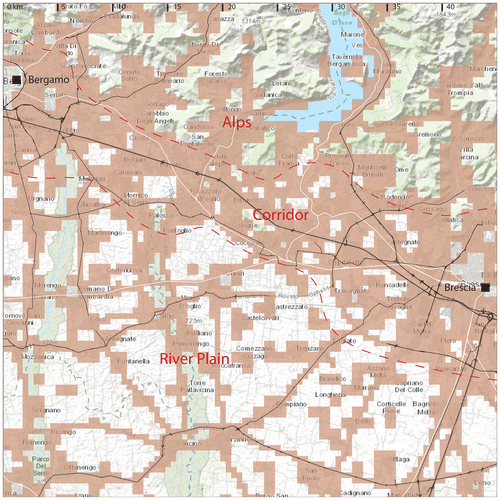
3.2. Selecting the relevant open spaces
This section showcases the methodology used to select specific green and grey open spaces. GIS-based analysis of data collected using remote sensing was used. The reason to use a remote sensing-based methodology was to have a fast and easily replicable method at hand that is independent from the provision of locally available data and expertise and therefore, would allow for easier cross-national comparisons. Freely available European wide spatial data-sets, like the CORINE land cover classification (EEA) could not be used as starting point, because green spaces in dispersed urban environments are always included in areas classified as discontinuous urban fabric, which do not show a distinction of open and built up spaces. A manual, expert-based classification based on a real image could have been an alternative approach, but it is excessively time intensive and difficult to reproduce.
Therefore, we decide to use the Normalized Difference Vegetation Index (NDVI) to locate open spaces. The NDVI is an index for the level of photosynthetic activity and is based on the fact that photosynthetically active vegetation absorbs most of the red light that hits it while reflecting much of the near infrared light. NDVI values capturing the case study areas were derived using Landsat 5 TM + images, which were acquired via U.S. Geological Survey and the following equation.
where R and IR are the spectral reflectance red and near-infrared bands, respectively. The NDVI equation produces values in the range from 0 to 200 with a raster resolution of 30 m. Values larger than 100 indicate vegetated areas and values smaller than 100 signify non-vegetated surface features. Values above 130 coincide in all 10 cases with green spaces as defined above. Values between 100 and 130, coincided with three types of grey spaces, ackers, big parking spaces around shopping malls or within industrial and commercial zones and low-rise residential areas with an high amount of paved surface and very little green. The last type would not qualify as open space as defined above. Therefore, we eliminated those areas with a NDVI value between 100 and 130, which are categorized as continuous or discontinuous urban areas according to the CORINE land cover classification.
The review of typologies presented in Chapter 2 suggested that neither present function, because of its instability, nor ownership, because of the hybrid nature of ownership of open spaces in TiB, could be used to classify open spaces effectively. That leaves size and configuration as basic features for the selection of open spaces. The latter will be expressed by the relation to the layers of network operators.
Van Herzele and Wiedemann (Citation2003) provide a classification of urban green spaces in relation with their size and accessibility. They consider only green spaces larger than 5 ha relevant for serving larger areas than a neighbourhood. This size seems also reasonable for TiB, for example, a single garden of a detached house may not be considered relevant for regional planning but a whole neighbourhood with big gardens is relevant for several aspects of sustainable development with a regional dimension, like urban climate, air quality and ecological connectivity. The same is true for streets with rows of trees. The positive effect of a single short street with trees may be very small but a system of streets with trees that crosses through several neighbourhoods can be of regional importance. Therefore, we decided to include all open spaces that are larger than 5 ha. Figure shows in a sequence of maps from left to right, the NDVI values for the complete case study area with a resolution of 30 m, the areas classified as TiB in the case study area in the middle and the opens space which are larger than 5 ha and are completely within TiB on the right.
3.3. Defining proxies for the layers of the adapted Dupuy model
In the following section, we describe the methods that allow us to describe the potential interaction of every single open space in all case study areas with the four layers from the model of network urbanism we have adopted. Every map produced in this step is subdivided in five zones, where zone 5 shows the highest potential for interaction and zone 1 show the lowest potential for interaction in the specific case.
3.3.1. Mapping the proximity to green infrastructure in TiB
For the classification of the potential interaction with the existing green infrastructure a proximity analyses with the following two steps was conducted: (i) the key landscape elements, which form the backbone of the regional green infrastructure were identified and (ii) the rest of the area was subdivided into four zones according to their Euclidian distance to the key landscape. The rather simple assumption is the longer the distance, the lower the potential for interaction.
As spatial proxy for the layer of green infrastructure we used those landscape elements that are considered to be the most important for a functional regional ecological system and provide the highest ecosystem services. These areas are legally protected areas like designated Natura 2000 areas, large unfragmented areas, which are crucial for ecological migration process and biodiversity, rivers and creeks, which are important ecocorridors. Furthermore, areas with complex cultivated land use pattern as well as agricultural areas with significant natural vegetation are included. All of these areas provide the ecosystem services, which were described in Section 2 as crucial for a sustainable spatial development. Table presents the geographic datasets that were used for this step, as well as the rationale that is behind using them, and the source of the data-sets.
Table 2. The geographic data features, which combined form the backbone of the green infrastructure within the case study areas.
The subdivision in five zones of potential for interaction is presented in Table
Table 3. Subdivision of five zones of potential interaction with the basic network of the green infrastructure.
Figure presents the resulting map for the demonstration case of Bergamo–Brescia. It shows the typical landscape mosaic for an area located in the transition from the Alps towards the river plains. Therefore, zone 5 is formed by the forested ridges of the Alps in the north, while further south we can identify batches of complex cultivation patterns on the peri-alpine hills. Three rivers, which drain the area and flow into the River Po form the most important regional ecological corridor in the area. Large batches of unfragmented agriculturally used areas in the south complete zone 5 of our classification. The rest of the map is a result of the classification according to the distances described in Table .
3.3.2. Mapping the density of network operators
As a spatial proxy for the potential for interaction of open spaces with the three network operators described in Section 2.3, as well as the network of households, density probability maps were produced. In these maps, we have used the number of companies and employees respective to the number of inhabitants in the area. The mapped areas were thereafter subdivided in five classes, where high density stands for a high potential and low density for low potential of interaction. The following five steps are common to all four maps.
| • | The address information that is provided by the Amadeus database (Bureau van Dijk, Citation2014), which contains comprehensive information on around 21 million companies across Europe, was used to generate a point file via the ESRI geocoding service. | ||||
| • | The Amadeus database provides a NANCE (Nomenclature of Economic Activities) code for every company. This code was used to assign the companies to the networks of production, consumption or infrastructure provision respectively. See Table for the assigned codes per category of network operators. | ||||
| • | These point files were then used to generate density probability map, using a kernel operation provide by a GIS software. For detail explanation of the kernel function (see Seaman & Powell, Citation2013). The density values were weighted by the number of employees per company. | ||||
| • | The kernel density values were reclassified into quintiles (five equal parts), where the grid cells with the 20% highest density value were assigned to class 5 and the 20% grid cells with the lowest density values to class 1. | ||||
Table 4. NACE codes and their categorization into operators of production, consumption and technical infrastructure.
Figures present the resulting maps of above-described operation for the demonstration case of Bergamo–Brescia. The four maps clearly show different spatial distributions for all four network operators. The households map (Figure ) shows the most dispersed pattern of densities, with peaks in Bergamo and Brescia and along the corridor between this two cities, but also in the plain in the south. The consumption map (Figure ) shows clear concentrations in the two big cities and along the highway, but here more concentrated around the highway exits. In the southern plain, a concentration on the lager towns, specifically those in vicinity to bridges over the rivers is visible. The production map (Figure ) shows concentrations along the complete highway corridor between Bergamo and Brescia and only a few peaks in the plain in south. The infrastructure map (Figure ) shows a different pattern, which is one of dispersed concentrations, both along the corridor between Bergamo and Brescia, but also in the southern plain.
Figure 6. The relation of open spaces to the kernel density of households as spatial proxy for the potential of interaction.
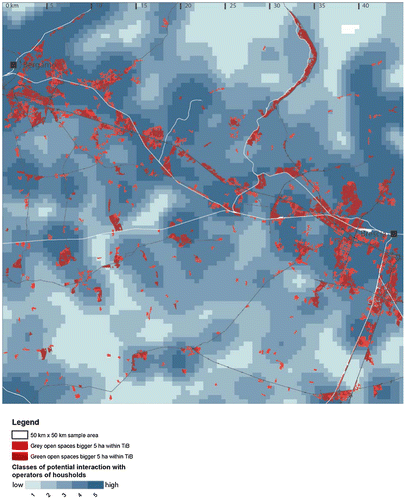
Figure 7. The relation of open spaces to the kernel density of operators of consumption as spatial proxy for the potential of interaction.
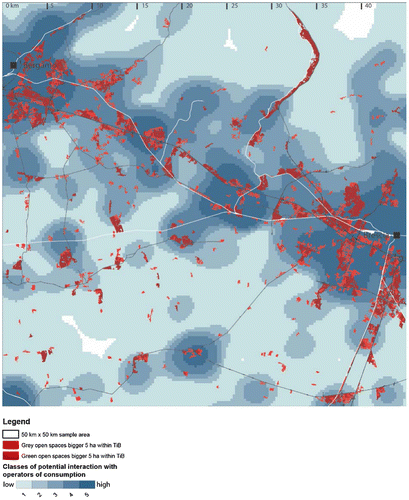
Figure 8. The relation of open spaces to the kernel density of operators of production as spatial proxy for the potential of interaction.
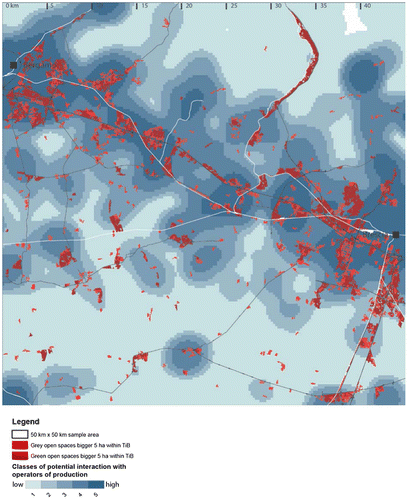
Figure 9. The relation of open spaces to the kernel density of operators of technical infrastructure as spatial proxy for the potential of interaction.
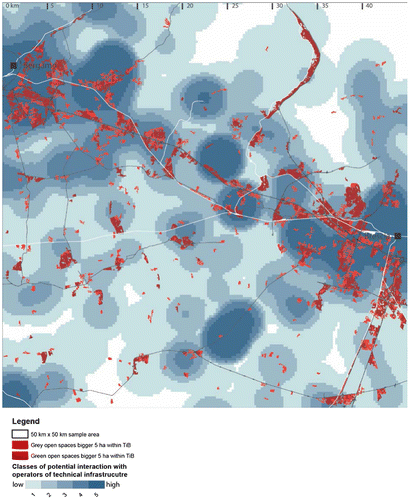
The observation of these differences is important, as it confirms the possibility, previously formulated theoretically, of using the potential of interaction with network operators as a distinctive characteristic of open spaces.
3.3.3. Mapping the quality of the service of technical infrastructure
The following sections describe how different types of network analyses measures were used to produce a map that presents, again in five classes, the quality of the street network in relation to open spaces in TiB for the three criteria of networks presented above. For all two maps, the street network provided by open street maps (OSM) was used as input data-set for the spatial analyses.
3.3.3.1. Topological criterion and adaptive criterion
We used the betweenness measure (Freeman, Citation1977), which identifies places that are structurally made to be traversed more often and therefore are considered central to the network. The urban network analyses toolkit (Sevtsuk & Mekonnen, Citation2012) and extension to ArcGis, was used to calculate the betweenness value for every street junction in the case study areas using the following formula:
Equation 1: The betweenness of a junction is defined as the fraction of shortest paths between pairs of other junctions in the network that pass by junction i. Betweenness measure is defined as follows:
where is the betweenness of junction i within the search radius r;
is the number of the shortest paths from junction j to junction k that pass by junction i;
is the total number of the shortest paths from j to k for more detail, see Sevtsuk and Mekonnen (Citation2012).
The resulting point map and the betweenness values of the junctions was than transformed to a raster representation using a kernel probability of density function. The resulting raster values were then reclassified into quintiles (five equal parts), where the grid cells with the 20% highest centrality value were assigned to class 5 and the 20% grid cells with the lowest density values to class 1. See Figure for the resulting density classification in relation to the green and grey open spaces for the demonstration case Bergamo–Brescia.
Figure 10. The open spaces in relation to the five classes of betweenness centrality of the street network in the case of Bergamo–Brescia.
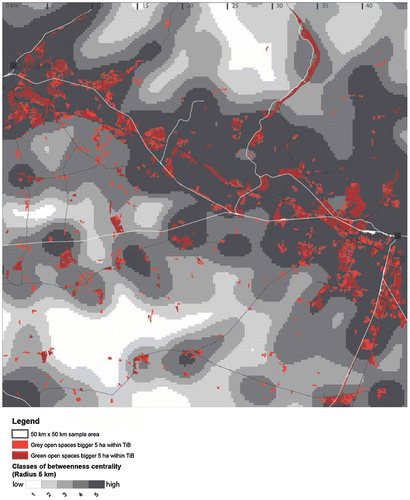
Figure shows clearly a broad corridor between Bergamo and Brescia with the highest betweenness centrality values. The zone of high centrality extends into the valleys of the alps to the north.
3.3.3.2. The kinetic criterion
As a proxy for the quality of a location in relation to the kinetic criterion of the street network we choose the network distance to entry points to the high-speed road networks as a measure for access to high-speed connections. The final map presented in Figure , was developed using the following steps:
| • | building the network data-set of the road network using OSM data; | ||||
| • | selecting those links (streets) which form the fast network (motorways and national roads); | ||||
| • | selecting the entry and exit points to the fast network; | ||||
| • | calculating the service areas—the areas that can be reached within a certain network distance—of this entry point using the complete road network; | ||||
| • | classifying the service areas into five categories (1500 m; 3000 m; 6000 m; 12,000 m; and >12,000 m); | ||||
| • | transforming the vector data-set into a raster data-set with a resolution of 250 m. | ||||
Figure 11. The relation of open space to the kinetic criterion of the street network in the case of Bergamo–Brescia.
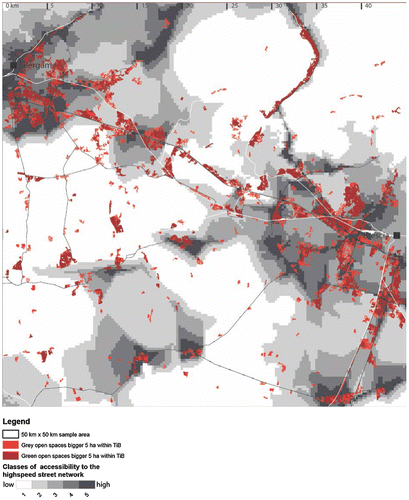
Figure resulting from the above methodology presents a clear concentration of the value 5 zone around the two big cities. The corridor between the cities is not accentuated very strongly.
The last paragraphs presented one way of translating Dupuy’s adapted concept of network urbanism into a series of analytical maps. These maps and the related spatial data allow us to compile a spatial database, which assigns a value between 1 and 5 for every layer to each open space within a TiB. These values express the level of potential interaction of the specific open spaces to the single layers of network operators and therefore to the network city understood as social–environmental system. Using SPSS, a two-step cluster analyses was performed to identify different types of open spaces. This explorative statistical method was used as it allows to run cluster analyses on large data that is not normal distributed and includes categorical variables, other commonly used clustering methods cannot be applied under this circumstances. The resulting typology consists of five green and five grey types, which are presented in the following section.
4. Results—a cross-national multidimensional typology of open spaces in TiB
The results section is organized in three parts, first we present the different types of open spaces, thereafter we describe the relation between the types of open space and the aspects of sustainable development introduced earlier and, finally, we present their distribution pattern within the 10 cases.
The cluster analyses resulted in 10 types of open spaces, 5 green types as well as 5 grey types. The radar diagrams presented in Figure show, that the grey types, with the exception of type 4, have a clear gradient from high potential to low potential of interaction in regards to all aspects. The green types show a more differentiated image, which means that they vary more in the potential of interaction with the network operators. Also, apparent from Figure shows that there are green and grey types, which are very similar, like types 1 and 3, types 5 and 6. The key difference, beside the intensity of coverage by plants, is the accessibility of the fast network, which is higher for the grey open spaces.
Figure 12. Radar diagrams displaying the types of open space in relation to their potential of interaction with the seven aspects of the networked city. The left diagram shows the green open spaces, the right diagram the grey open spaces.
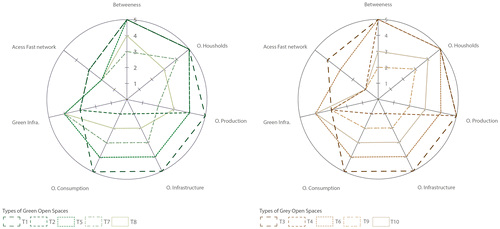
Table presents a description of the key features of the different types of open spaces as well as an assessment, that enable us to relate the different types of open spaces to a more sustainable development of TiB in reference to the earlier described ecosystem services. This assessment is of course limited as it a generalization across Europe and focuses on the regional scale.
Table 5. The relation between the different types of opens spaces in TiB and examples of their potential contribution to sustainable development and related ecosystem services. In order to avoid repetition, types of green and grey open spaces with similar characteristics were grouped.
Figure shows that type 5 covers the largest area across cases of the green types, followed by type 1 and 2. Types 9, 10 and 6 are the types of grey spaces that cover the largest area across all cases. The most frequent type of green space is type 1. Type 10 is the most frequent grey open space. Type 4 is the only type, which is only playing an important role in one single case. In the UK, Italy and to a certain extend also in the Netherlands, both case show a similar distribution patterns of types.
Figure 13. Comparison of amount and area of each type of open spaces across the 10 case study areas across Europe.
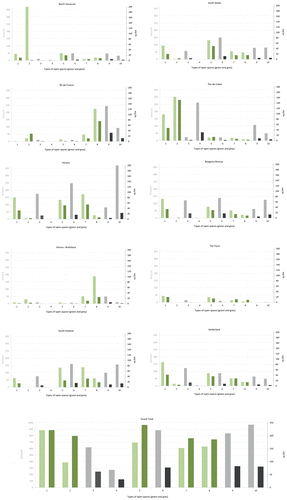
There are four different limitations we think are important to consider when using the typology presented in this paper:
| • | The assignment of the NANCE codes to the different operators in Table . The border between operators of production and infrastructure is sometime not very apparent or certain codes are a combination of both. A slightly different classification would be plausible and may influence the typology. | ||||
| • | The selected value for the NDVI that separated the grey from the green open space led to the situation, that acres without vegetation are considered as grey spaces, which is not true for the period of the year they carry crop. | ||||
| • | The assessment of possible contributions of the single types toward a more sustainable development is limited as it a generalization across Europe and focuses on the regional scale, specific local solutions may vary significantly. | ||||
5. Discussion and conclusion
In this article, we presented an initial framework based on solid empirical spatial analysis of TiB to inform policies for a more sustainable spatial development of TiB. We did so by investigating the potential contribution of different types of open spaces to sustainable development.
According to Lovell and Taylor (Citation2013), urban ecosystems, and therefore open spaces in TiB, are becoming increasingly important as contributors to both the problems and potential solutions to the environmental issues in the near future. The globally ongoing expansion of urban areas and the loss of more rural or ‘natural’ landscapes require that crucial ecosystem services have to be supplied by urban grey and green spaces.
At the same time, these spaces must continue to meet the traditional cultural needs of nearby residents by encouraging recreational activities, embodying the aesthetic preferences of the community, educating people about nature, and preserving historic landscape features. These various functions, which provide the ‘ecosystem services’ that benefit humans directly or indirectly, will need to be considered simultaneously and to be balanced to meet the needs and preferences of local residents as well as society as a whole (Lovell & Taylor, Citation2013, p. 1).
Finally, we present one further possible application of the developed typology. The European Landscape Convention (ELC) (Council of Europe, Citation2000) defines the whole territory as landscape, explicitly including urbanized areas. For this article, it is relevant to point out that the ELC calls upon signatory states to identify their landscapes, and to explicitly include urban and peri-urban landscapes in the description, in addition to the ‘natural’ and ‘rural’ ones (ELC Article 2). If this identification is to go ‘beyond the traditional focus on individual parks and green spaces and the links between them’ (Stiles et al., Citation2014), then two challenges are crucial: (i) to include also non-green open spaces and (ii) to base the classification of open spaces in more than ecological and environmental aspects. The typology presented in this paper does both and goes beyond. Because, it not only allows to identify open spaces, green and grey, based on social–environmental aspects, but it also provides a tool to identify their potential for multifunctionality and can thereby inform planning decisions on multiple scales.
Figure presents this characterization of the landscape through types of open spaces for our demonstration case Bergamo–Brescia.
References
- Aalbers, C. & Eckerberg, K. (2011) Governance patterns and performance of regional strategies in peri-urban areas. Available at http://www.plurel.net/images/D338.pdf.
- Amati, M. & Taylor, L. (2010) From green belts to green infrastructure, Planning Practice and Research, 25(2), pp. 143–155. doi:10.1080/02697451003740122.
- Andexlinger, W., Kronberger, P., Mayr, S., Nabielek, K., Ramière, C. & Staubmann, C. (2005) TirolCity (Vienna: Folio Verlag).
- Braat, L. C. & de Groot, R. (2012) The ecosystem services agenda: bridging the worlds of natural science and economics, conservation and development, and public and private policy, Ecosystem Services, 1(1), pp. 4–15. doi:10.1016/j.ecoser.2012.07.011.
- Bruegmann, R. (2005) Sprawl: A Compact History, (Chicago, IL: University of Chicago Press). Available at http://www.loc.gov/catdir/toc/ecip059/2005007591.html.10.7208/chicago/9780226076973.001.0001
- Bureau van Dijk. (2014) A Database of Comparable Financial Information for Public and Private Companies Across Europe (Amsterdam: Author).
- Campi, M., Bucher, F. & Zardini, M. (2000) Annähernd perfekte Peripherie [An almost perfect periphery]: Glattalstadt/Greater Zurich Area (German Edition) (Birkhäuser Basel). Available at http://www.amazon.com/Ann%C3%A4hernd-perfekte-Peripherie-Glattalstadt-Greater/dp/3764363118.
- Carmona, M. (2010a) Contemporary public space: part one, critique, Journal of Urban Design, 4809(September), pp. 123–148. doi:10.1080/13574800903435651.
- Carmona, M. (2010b) Contemporary public space, part two: classification, Journal of Urban Design, 15(2), pp. 157–173. doi:10.1080/13574801003638111.
- Carr, S. (1992) Public Space (Cambridge University Press). Available at https://books.google.com/books?hl=en&lr=&id=pjo4AAAAIAAJ&pgis=1.
- Caso, O. (1999) The City, the Elderly, and Telematics. Design Aspects of Telematic Applications in a Residential Neighbourhood, PhD thesis, Delft University of Technology, Spatial Planning Group. Transformation no. 2.
- Couch, C., Leontidou, L. & Gerhard, P.-H. (Eds) (2007) Urban Sprawl in Europe: Landscapes, Land-use Change & Policy (Oxford: Blackwell).
- Council of Europe. (2000) European Landscape Convention (Florence: European Treaty Series).
- Cranz, G. & Boland, M. (2004) Defining the sustainable park: a fifth model for urban parks, Landscape Journal, 23(2), pp. 102–120. doi:10.3368/lj.23.2.102.
- Crompton, J. L. (2001) The impact of parks on property values: a review of the empirical evidence, Journal of Leisure Research, 33(1), pp. 1–31. Available at http://www.scopus.com/inward/record.url?eid=2-s2.0-0008506946&partnerID=tZOtx3y1.
- Davies, C., MacFarlane, R. & McGloin, C. (2015) Green Infrastructure Planning Guide. Available at http://www.greeninfrastructurenw.co.uk/resources/North_East_Green_Infrastructure_Planning_Guide.pdf.
- Dessemontet, P., Kaufmann, V. & Jemelin, C. (2010) Switzerland as a single metropolitan area? A study of its commuting network, Urban Studies, 47(13), pp. 2785–2802. doi:10.1177/0042098010377371.
- Dupuy, G. (1991) L’urbanisme des réseaux. Théories et méthodees [Network urbanism. Theory and methods] (Paris: Armand Colin).
- Dupuy, G. (2008) Urban Networks-Network Urbanism (Amsterdam: Techne Press).
- Ehrlich,P. R. & Ehrlich, A. H. (1982) Extinction: The Causes and Consequences of the Disappearance of Species. Available at http://books.google.nl/books/about/Extinction.html?id=KUwzHAAACAAJ&pgis=1.
- Farley, J. (2012) Ecosystem services: The economics debate, Ecosystem Services, 1(1), pp. 40–49. doi:10.1016/j.ecoser.2012.07.002.
- Fishman, R. (1990) Metropolis unbound: the new city of the twentieth century, Flux, 6(1), pp. 43–55. doi: http://doi.org/10.3406/flux.1990.1172.
- Freeman, L. C. (1977) A set of measures of centrality based on betweenness, Sociometry, 40(1), p. 35–41. doi:10.2307/3033543.
- Frijters, E., Hamers, D., Ku¨rschner, J., Lo¨rzing, H., Nabielek, K., Rutte, R., … Van Veelen, P. (2004) Tussenland [In-between land] (Rotterdam: NAi Uitgevers). Available at http://www.worldcat.org/title/tussenland/oclc/254976120.
- Gallent, N., Bianconi, M. & Andersson, J. (2006) Planning on the edge: England’s rural–urban fringe and the spatial-planning agenda, Environment and Planning B Planning and Design, 33(3), pp. 457–476. Available at http://eprints.ucl.ac.uk/70921/.10.1068/b31171
- Gallent, N., Shoard, M., Andersson, J., Oades, R. & Tudor, C. (2004) Inspiring England’s urban fringes: multi-functionality and planning, Local Environment, 9(3), pp. 217–233. doi:10.1080/1354983042000219342.
- Garreau, J. (1992) Edge City: Life on the New Frontier (Anchor). Available at http://www.amazon.com/Edge-City-Life-New-Frontier/dp/0385424345.
- Girvetz, E. H., Thorne, J. H., Berry, A. M. & Jaeger, J. A. G. (2008) Integration of landscape fragmentation analysis into regional planning: a statewide multi-scale case study from California, USA, Landscape and Urban Planning, 86(3–4), pp. 205–218. Available at http://www.sciencedirect.com/science/article/B6V91-4SDNK43-1/2/d62be500b00ddee101b53c22785574b4.10.1016/j.landurbplan.2008.02.007
- Hajer, M. & Reijndorp, M. (2001) In Search of New Public Domain (Rotterdam: NAi).
- Harnik, P. (2012) Urban Green: Innovative Parks for Resurgent Cities (Island Press). Available at https://books.google.com/books?hl=en&lr=&id=cTAJZy765RsC&pgis=1.
- Ibes, D. C. (2015) A multi-dimensional classification and equity analysis of an urban park system: a novel methodology and case study application, Landscape and Urban Planning, 137, pp. 122–137. doi:10.1016/j.landurbplan.2014.12.014.
- Indovina, F. (1990) La città diffusa (The Diffuse City) (Venice: Dipartimento diAnalisi Economica e Sociale del Territorio, Istituto Universitario di Architettura).
- Jacobs, J. (1961) The Death and Life of Great American Cities. Available at http://books.google.nl/books/about/The_Death_and_Life_of_Great_American_Cit.html?id=P_bPTgOoBYkC&pgis=1.
- Kambites, C. & Owen, S. (2006) Renewed prospects for green infrastructure planning in the UK 1, Planning Practice and Research, 21(4), pp. 483–496. doi:10.1080/02697450601173413.
- Kühn, M. (2003) Greenbelt and green heart: separating and integrating landscapes in European city regions, Landscape and Urban Planning, 64(1–2), pp. 19–27. doi:10.1016/S0169-2046(02)00198-6.
- Lovell, S. T. & Taylor, J. R. (2013) Supplying urban ecosystem services through multifunctional green infrastructure in the United States, Landscape Ecology, 28(8), pp. 1447–1463. doi:10.1007/s10980-013-9912-y.
- Low, S., Taplin, D. & Scheld, D. (2005) Rethinking Urban Parks: Public Space and Cultural Diversity (Austin, TX: University of Texas Press).
- Maas, J., Verheij, R. A., Groenewegen, P. P., de Vries, S. & Spreeuwenberg, P. (2006) Green space, urbanity, and health: how strong is the relation? Journal of Epidemiology and Community Health, 60(7), pp. 587–592. doi:10.1136/jech.2005.043125.
- Matsuoka, R. H. & Kaplan, R. (2008) People needs in the urban landscape: analysis of Landscape And Urban Planning contributions, Landscape and Urban Planning, 84(1), pp. 7–19. doi:10.1016/j.landurbplan.2007.09.009.
- Mell, I. C. (2009) Can green infrastructure promote urban sustainability? Proceedings of the Institution of Civil Engineers – Engineering Sustainability, 162(1), pp. 23–34. doi:10.1680/ensu.2009.162.1.23.
- Millennium Ecosystem Assessment (2005) Ecosystems and Human Well-being: Synthesis (Washington, DC: Island Press).
- Moudon, A. V. (1994) Getting to know the built landscape: typomorphology, in: A. F. Karen & L. H. Schneekloth (Eds) Ordering Space: Types in Architecture and Design (New York, NY: Van Nostrand Reinhold).
- Müller, F. & Burkhard, B. (2012) The indicator side of ecosystem services, Ecosystem Services, 1(1), pp. 26–30. doi:10.1016/j.ecoser.2012.06.001.
- Nadin, V. & Stead, D. (2013) Opening up the compendium: an evaluation of international comparative planning research methodologies, European Planning Studies, 21(10), pp. 1542–1561. doi:10.1080/09654313.2012.722958.
- Niemelä, J., Saarela, S.-R., Söderman, T., Kopperoinen, L., Yli-Pelkonen, V., Väre, S. & Kotze, D. J. (2010) Using the ecosystem services approach for better planning and conservation of urban green spaces: a Finland case study, Biodiversity and Conservation, 19(11), pp. 3225–3243. doi:10.1007/s10531-010-9888-8.
- Pincetl, S., Bunje, P. & Holmes, T. (2012) An expanded urban metabolism method: toward a systems approach for assessing urban energy processes and causes, Landscape and Urban Planning, 107(3), pp. 193–202. doi:10.1016/j.landurbplan.2012.06.006.
- Read, S. (2013) Intensive urbanisation: levels, networks and central places, The Journal of Space Syntax, 4(1), pp. 1–17.
- Regional Statistics Team. (2013) Urban-Rural Typology Update – Statistics Explained. Statistics in Focus, Vol. 16. Available at http://ec.europa.eu/eurostat/statistics-explained/index.php/Urban-rural_typology_update.
- Rocco, R. (2008) An Urban Geography of Globalisation: New Urban Structures in the Age of Hyper-connectivity (Delft: TU Delft).
- Rooij, R. M. (2005) The Mobile City: The Planning and Design of the Network City from a Mobility Point of View, TRAIL thesis series. Available at http://trid.trb.org/view.aspx?id=760528.
- Sandercock, L. (2004) Towards a planning imagination for the 21st century, Journal of the American Planning Association, 70(2), pp. 133–141. doi:10.1080/01944360408976368.
- Sandstroem, U. (2002) Green infrastructure planning in urban green infrastructure planning in urban Sweden, Planning Practice and Research, 17(4), pp. 37–41. doi:10.1080/0269745032000074461.
- Seaman, D. E. & Powell, R. A. (2013) An evaluation of the accuracy of kernel density estimators for home range analysis, Ecological Society of America, 77(7), pp. 2075–2085.
- Sevtsuk, A. & Mekonnen, M. (2012) Urban network analysis a new toolbox for ArcGIS, Revue Internationale de Géomatique, 2, pp. 287–305. doi:10.3166/RIG.22.287-305.
- Sieverts, T. (2007) Metropolitan landscapes: attitudes, research and practice, Places: Forum of Design for the Public Realm, 19(1), pp. 28–35.
- Sieverts, T. (2003) Cities Without Cities An Interpretation of the Zwischenstadt (London: Routledge).
- Sieverts, T. & Bölling, B. (Eds) (2004) Mitten am Rand. Auf dem Weg von der Vorstadt ueber die Zwischenstadt zur regionalen Stadtlandschaft [In the middle of the periphery: From suburb via Zwischenstadt towards and urban landscape]. (T. Sieverts & L. Bölling (Eds)) Wuppertal: Verlag Müller + Busmann KG. Available at http://mueller-busmann.com/tl_files/mb/pdf/DaimlerBand1Inhalt.pdf
- Sitte, C. (1889/2002) Der Städtebau nach seinen künstlerischen Grundsätzen [City planning according to artistic principles] (Basel: Birkhäuser).
- Smith & Stirling. (2010) The politics of social-ecological resilience and sustainable socio-technical transitions, Ecology and Society, 15(1), Article 11. Available at http://www.ecologyandsociety.org/vol15/iss1/art11/
- Stanley, B. W., Stark, B. L., Johnston, K. L. & Smith, M. E. (2012) Urban open spaces in historical perspective: a transdisciplinary typology and analysis, Urban Geography, 33(8), pp. 1089–1117. doi:10.2747/0272-3638.33.8.1089.
- Stiles, R., Gasienica-wawrytko, B., Hagen, K., Loibl, W., Tötzer, T., Köstl, M. & Pauleit, S. (2014) Understanding the whole city as landscape. A multivariate approach to urban landscape morphology, Spool, 1, pp. 401–418.
- Swanwick, C., Dunnett, N. & Woolley, H. (2003) Nature, role and value of green space in towns and cities: an overview, Built Environment, 29(2), pp. 94–106. doi:10.2148/benv.29.2.94.54467.
- Talen, E. (2010) The spatial logic of parks, Journal of Urban Design, 15(4), pp. 473–491. doi:10.1080/13574809.2010.502335.
- Tzoulas, K., Korpela, K., Venn, S., Yli-Pelkonen, V., Kaźmierczak, A., Niemela, J. & James, P. (2007) Promoting ecosystem and human health in urban areas using green infrastructure: a literature review, Landscape and Urban Planning, 81(3), pp. 167–178. doi:10.1016/j.landurbplan.2007.02.001.
- Ulied, A., Biosca, O. & Rodrigo, R. (2010) Urban and Rural Narratives and Spatial Development. (Barcelona: MCRIT).
- Van Herzele, A. & Wiedemann, T. (2003) A monitoring tool for the provision of accessible and attractive urban green spaces, Landscape and Urban Planning, 63(2), pp. 109–126. doi:10.1016/S0169-2046(02)00192-5.
- Viganò, P. (2001) Territori della nuova modernità Provincia di Lecce, Assessorato alla gestione territoriale: Piano territoriale di coordinamento = Territories of a new modernity. Finibusterra [Territories of a new modernity: A Strategic Plan for the Province of Lecce] (Napoli: Electa).
- Viganò, P. (2011) Introduction, in: F. Viviana, S. Angelo & V. Paola (Eds) Landscapes of Urbanism, pp. 8–15. (Vencia: IUAV Venezia).
- Volker, B., Flap, H. & Lindenberg, S. (2006) When are neighbourhoods communities? Community in Dutch neighbourhoods, European Sociological Review, 23(1), pp. 99–114. doi:10.1093/esr/jcl022.
- Wandl, A., Nadin, V., Zonneveld, W. & Rooij, R. (2014) Beyond urban–rural classifications: characterising and mapping territories-in-between across Europe, Landscape and Urban Planning, 130, pp. 50–63.10.1016/j.landurbplan.2014.06.010
- Wandl, A., Rooij, R. & Rocco, R. (2012) Understanding the planning of open spaces in territories-in-between : Dupuy ’ s network urbanism approach applied to areas in-between Urban and Rural. In RSA European Conference 2012, May 13–16, Delft, The Netherlands.
- Whyte, W. H. (1980) The Social Life of Small Urban Spaces. Available at http://trid.trb.org/view.aspx?id=521122.

